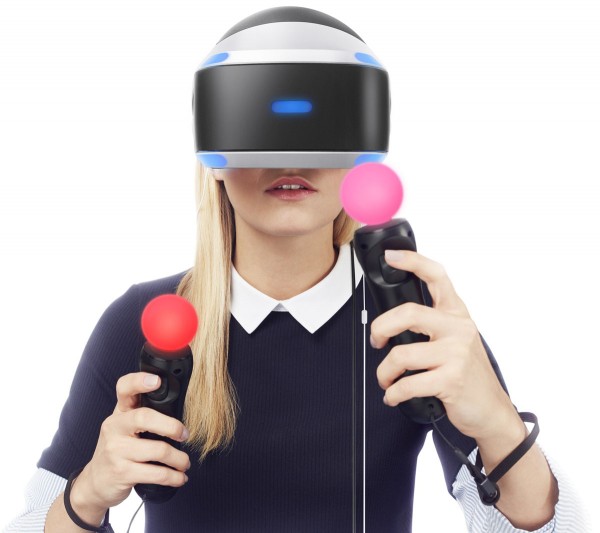
In less than 24 hours, and for some, in less than 12 hours, PlayStation VR will launch and mark the official launch of virtual reality as we know it. Sure, there have been VR rigs in the past and perhaps most notably, the arrival of Oculus Rift and HTC Vive 6 months ago, but to a degree, both systems have been met with a shrug. Sure, you’ll read about how amazing each system is on tech blogs (and they are quite great), but that means little when VR’s biggest challenge is getting to consumers. For them, each system is too cumbersome to put on, limited in terms of where/how you can use them, and most importantly, far too expensive. On top of that, the general consumer has never heard of either brand – but PlayStation? That’s a name known all too well by gamers and non-gamers alike.
Geoffrey A. Fowler has written a pretty great PlayStation VR review for the WSJ, but perhaps the most profound part of the review if he’s right (and I believe he is) is how he starts it off:
It’s only October, and I’ve already discovered what your teenagers will beg for this Christmas: Sony PlayStation VR.
As I mentioned, Sony isn’t the first to VR, but because of PlayStation’s brand loyalty and scale, they’re the first one to matter. In a lot of ways, what PlayStation is doing with VR is how Apple treats a lot of technologies. They are seldom first to a market, but when they do launch, they have the ability to fundamentally shift and push it forward. With VR, even if Oculus and HTC were to have no competition for another two years, I highly doubt their traction would grow to anything sizable, but by the end of this year, Sony will likely have sold what will add up to both units’ sales combined for the next two years. In a lot of ways, consumers will get their first real taste of VR through PlayStation – and if it’s disastrous, at best, it will slow the adoption of virtual reality, and at worst, cripple it for some time to come.
As Fowler notes in his PlayStation VR review:
This isn’t a story about better tech. Sony’s much-hyped rivals, Oculus Rift and HTC Vive, which must be connected to powerful PCs, offer more sophisticated virtual reality experiences. (Vive remains my favorite tech demo of the year—it can fill an entire room with a virtual whale!) But Sony has wisely traded technical capability for something VR needs much more right now: broader appeal. PlayStation VR moves it out of the realm of expensive geek tech, and into something that fits in an actual family room.
And that’s just it: both the Rift and Vive have some really cool demos and are far more powerful, so don’t see this as a negative take on them. However, the broader consumer seldom cares about that. What’s king to them is price and content. Plug and play should also not be underestimated. Who wants to go through the hell that is Windows and its drivers and system specs, just to figure out if either of those headsets will actually work? On the other hand, if you own a PS4, PS VR will work.
PlayStation VR’s family-friendly appeal begins with the fact that it works with any PS4. There are already 40 million PS4s in homes around the globe, and a new one sets you back as little as $300. In addition to the full $500 kit, there is a pared-down $400 PSVR setup for people who already own the camera and Move sticks.
Unwrap a few new pieces of PSVR hardware, swap around a few plugs on your existing PS4, and you’re set up in under 15 minutes. (With the Rift and Vive, I regretted not getting an engineering degree. You need to connect them to a high-end PC, with special graphics cards and drivers.)
As for the competition, even if you have the necessary computers to run them, you’ll then have to move around a lot of furniture and place awkward wired cameras (yes, more than one) just to get things running.
You can use PSVR without remodeling your house—or designating a spotter to ensure you don’t chip a tooth on the coffee table. And that may be PlayStation VR’s greatest feature: Instead of requiring you to fire up a Windows PC then creep around furniture, it’s just sitting there, ready for a rainy day escape or fun with friends.
Sony made some practical choices so its VR goggles are less annoying to wear. While the Sony headset weighs about as much as the Oculus headset, it felt less heavy because of how it rests on your head. Flaps along the edges allow for air flow and block ambient light, though some people may still see some. I wore it for 45-minute stretches without steaming up the lenses or having my face feel hot.
As I’ve mentioned in many pieces before, good technology is less about total specs and more about how you put them to use. I’ve hammered Sony Mobile on this many times; despite having higher megapixel cameras than the competition, namely iPhone, Xperia cameras routinely take inferior photos. That’s because it’s all about the software that drives the cameras and clearly Sony hasn’t been able to master that.
Inside the headgear, you’ve got about a 100-degree field of view, which is just narrow enough that it’s hard to forget you’re wearing goggles. But Sony’s lenses and displays—which contain three “subpixels” for each of its more than 2 million pixels—do a better job than competitors at erasing the feeling that you’re looking through a screen door. The displays also use a very fast refresh rate—up to 120 Hz—so looking at them while moving around left me feeling less queasy than Oculus Rift.
Audio helps PlayStation VR move you. It can deliver audio (either to the included headphones or to your own favorite pair) that is specific to where you are in the virtual world. In the free 20-minute movie “Allumette,” an animated O. Henry-style story you watch from the clouds, at one point I heard some muffled sniffles that made me move around to find a hidden character. “Allumette” was the first VR experience that made me tear up.

One of the biggest differences between PS3 and PS4 is how social the latter console is. From day one, Sony understood that social meant more than just online multiplayer; that it was sharing an experience with others via recording videos and/or taking screenshots and being able to share them on Facebook and Twitter on top of capabilities to livestream. With PS VR, Sony is once again taking social into account, albeit in a different manner. Sony is clearly aware that in order for PS VR and virtual reality as a whole to succeed, it has to be enjoyed by as many people as possible. That means hands-on time with it, which is the only way to truly grasp what VR can really offer.
PlayStation VR comes with a “social screen” option, which lets friends (and annoying little brothers) watch what’s happening inside the VR goggles on the nearby TV.
Sharing the PlayStation VR with me over lunch, Nathan jeered when he saw my virtual Batman appear on the TV—and fail to incapacitate the Penguin’s henchmen in time. We passed the headset back and forth with ease. Unlike competitors’ headset designs, PlayStation’s doesn’t involve adjustable Velcro straps for different head sizes. The PSVR headset pulls apart with tension, instantly fitting different-sized heads and noses; a knob in back tightens the whole thing.
It’s hard to say what the future of VR is going to be, but one thing is for certain: after this holiday season, virtual reality will have arrived. From here, the amount of quality and compelling content alongside even lower price points will be the two key drivers of growth for the entire VR industry – and for the first time in a long time, Sony is finding itself in a unique position to lead an entire industry.
Discuss:
With all the positive reviews of PS VR, are you more likely to give it a try?

You must be logged in to post a comment.